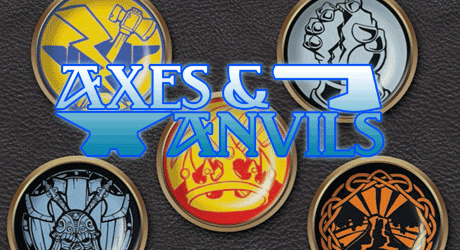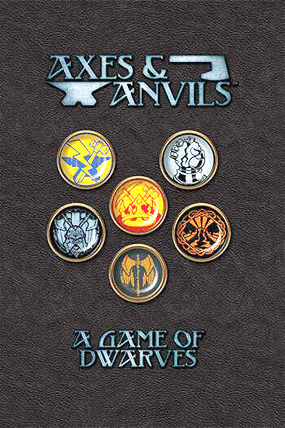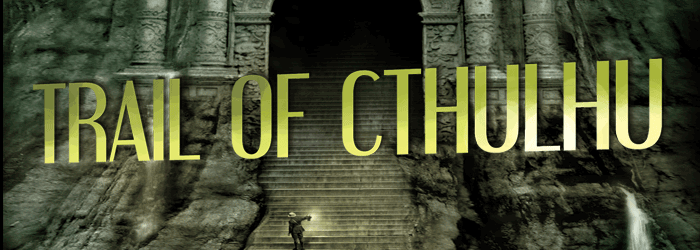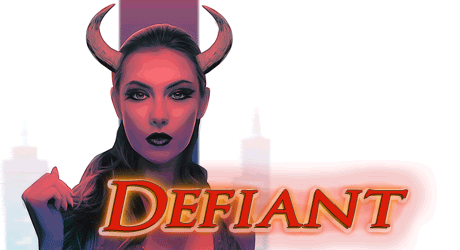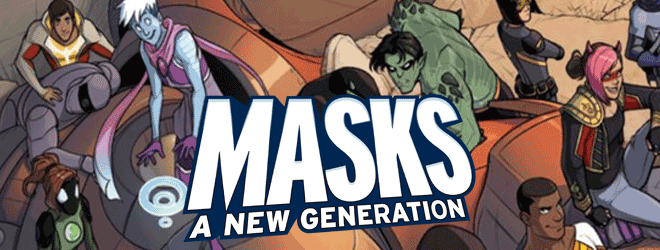In January 2024 we presented the Axes and Anvils Bundle featuring Axes and Anvils: A Game of Dwarves, the dwarf-clan FRPG from Andrew Shields at Shields Up! Publishing. In the underground Kingdom of Stoneshadow, your Fellowship of experienced warriors undertakes missions to help your clan. Axes and Anvils character creation is fast and easy, the setting is strong in flavor and atmosphere, and the clan framework easily supports both one-evening adventures and years-long sandbox campaigns in the open-table “West Marches” style. If you like kickass warriors, player-driven action, and battles against undead warbands in the Shadowmines, Axes and Anvils is your Dynastic Prestige toolkit for crafting mithril-grade adventures.
Like a deep-delving Moria mineshaft, Axes and Anvils took a long and shadowed path to its goal. In 2012 Mike Nystul (The Whispering Vault) ran three successive Kickstarter campaigns for Axes and two other games, but delivered little for any of them. “It became clear the game was not going to be finished,” Andrew Shields says. “I saw and felt the game’s potential and got involved to help finish it. Eventually I acquired the rights to Axes and Anvils. I am not responsible for any of the rewards promised by the Kickstarter, nor did I receive any funds from it. I finished developing the game on my own. Axes and Anvils is not, in the end, the game Mike Nystul would have made – but it has the same goals he put forth” – to wit, “the dwarfy-est game ever.”
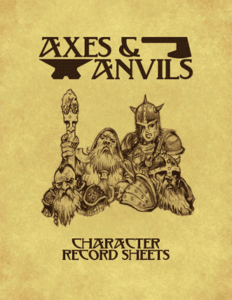 Even starting characters in Axes and Anvils are experienced (by default, they’re more than 50 years old) and quite tough. You have a named weapon, a Guiding Saying, possibly a mystic ability, one of 12 service skills (doing something), and one of 12 craft skills (making something); one skill is primary, one secondary. Task resolution uses 1d12; a primary skill succeeds on 5+, secondary skills on 6+. There are d12-based risk tests (saving throws). Spend your dwarf’s Resolve points to add 1d4 to any result after rolling, or to make a Hero Test to attempt unreasonable actions.
Even starting characters in Axes and Anvils are experienced (by default, they’re more than 50 years old) and quite tough. You have a named weapon, a Guiding Saying, possibly a mystic ability, one of 12 service skills (doing something), and one of 12 craft skills (making something); one skill is primary, one secondary. Task resolution uses 1d12; a primary skill succeeds on 5+, secondary skills on 6+. There are d12-based risk tests (saving throws). Spend your dwarf’s Resolve points to add 1d4 to any result after rolling, or to make a Hero Test to attempt unreasonable actions.
Your dwarf has a Combat Role (Leader, Skirmisher, Mauler, Vanguard, Berserker, Support), a style that determines your combat rating and Vitality (hit points). To attack, roll equal to or higher than the target’s combat rating on 1d12. Your role determines the damage you inflict to the target’s Vitality. Armor reduces damage. If you hit Vitality 0, you fall unconscious; if you lose 6 Vitality at once, you suffer a Wound; you die after six Wounds. There are firearms and grenades.
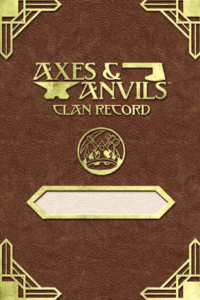 The Axes and Anvils rules grant many bonuses for helping other characters, and this highlights the game’s strong focus on the dwarven clan. Players jointly generate their clan: its Identity, its ratings in Prestige and Strength and Wealth, and its Allegiance to one or another of the five Overclans (Bloodcrag, Shieldsplitter, Stondraeg, Stonebreaker, Thunderforge). All characters belong to the same Fellowship in their clan. The Fellowship undertakes missions to serve the clan. You gain Ledger (experience from a mission) by Telling the Tale of your adventure at a ritual feast.
The Axes and Anvils rules grant many bonuses for helping other characters, and this highlights the game’s strong focus on the dwarven clan. Players jointly generate their clan: its Identity, its ratings in Prestige and Strength and Wealth, and its Allegiance to one or another of the five Overclans (Bloodcrag, Shieldsplitter, Stondraeg, Stonebreaker, Thunderforge). All characters belong to the same Fellowship in their clan. The Fellowship undertakes missions to serve the clan. You gain Ledger (experience from a mission) by Telling the Tale of your adventure at a ritual feast.
This framework nicely supports a West Marches campaign style – what the Axes rulebook calls “open table.” Microscope designer Ben Robbins explained the idea in an October 2007 entry in his Ars Ludi blog, “Grand Experiments: West Marches,” and a May 2008 follow-up post, “Running Your Own.” A West Marches sandbox campaign has a rotating cast of 12-20 players who proactively plan each session, setting a goal given the in-game knowledge they have. If (say) four to six players commit to a session next week that explores the haunted mine they heard about, they inform the Game Master, who prepares the requested scenario. As Aaron Marks said on the Cannibal Halfling blog (27 Oct 2021), “West Marches fulfilled two different but equally intriguing design goals: First, the game would be driven by exploration above all else; second, the game could be played by adults with difficult schedules by removing the need for everyone to agree on one set time to play in a given week (or month). West Marches is a great way to solve two of the group organizer’s biggest problems: balancing everyone’s schedule and making sure everyone gets to play.”
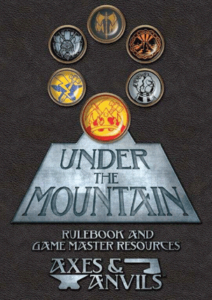 The Axes and Anvils clan focus suits the open-table West Marches approach. Individual players drop in or out, but the clan motivates any arbitrary group of characters toward a common goal, discouraging infighting and giving everyone a reason to fight a common threat. The clan requires a broad range of services: scouting, diplomacy, search and rescue, treasure hunts, even siege warfare. “I see this game like a musical instrument, empowering novices and showcasing virtuosos,” says designer Andrew Shields in Under the Mountain. “You can use the same guitar to strum some basic chords or to shred that complex solo. Axes and Anvils can support a one-off convention game or a years-long campaign. You can sink a lot of time into crafting your world – but with the tools here, you can also make it up as you go.”
The Axes and Anvils clan focus suits the open-table West Marches approach. Individual players drop in or out, but the clan motivates any arbitrary group of characters toward a common goal, discouraging infighting and giving everyone a reason to fight a common threat. The clan requires a broad range of services: scouting, diplomacy, search and rescue, treasure hunts, even siege warfare. “I see this game like a musical instrument, empowering novices and showcasing virtuosos,” says designer Andrew Shields in Under the Mountain. “You can use the same guitar to strum some basic chords or to shred that complex solo. Axes and Anvils can support a one-off convention game or a years-long campaign. You can sink a lot of time into crafting your world – but with the tools here, you can also make it up as you go.”
This all-new Axes and Anvils offer presented the entire line: the complete Axes and Anvils core rulebook (plus the Clan Record Book, the Character Pack, and the pay-what-you-want Quickstart Rules), the Under the Mountain Game Master’s handbook, and the Starter Deck and Lore Deck.
May your tunnels be ever sturdy, and may your beard grow as strong as your courage!
